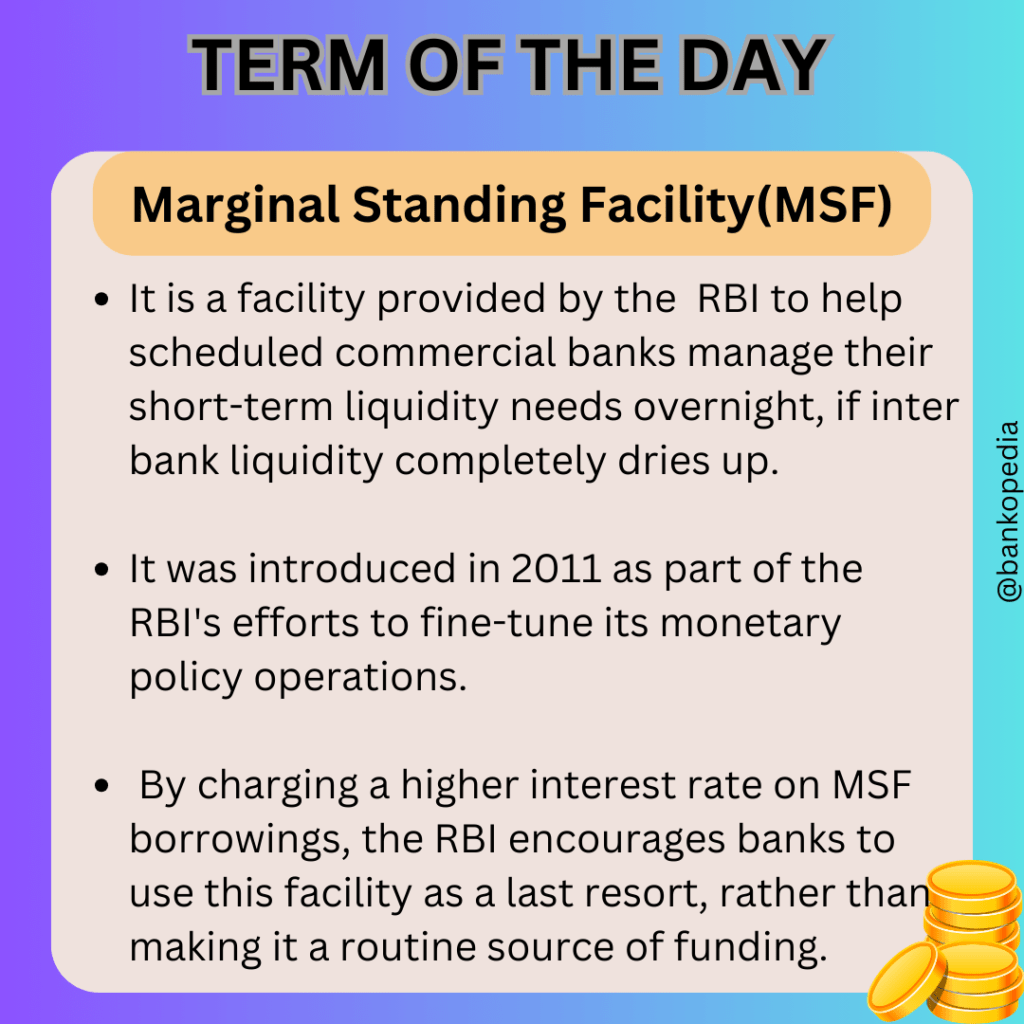Table of Contents
The Marginal Standing Facility (MSF) refers to the interest rate at which banks borrow money from the Reserve Bank of India (RBI) overnight. In exchange for authorized government securities, this funding window was introduced in 2011 to help lenders avoid crises and keep cash flowing. However, the MSF rate is greater than the repo rate. This is especially important in emergency situations, such as when interbank liquidity dries up and the overnight interbank rate becomes unstable.

Marginal Standing Facility (MSF) Scheme
Eligibility for Marginal Standing Facility:
Participation in the Marginal Standing Facility (MSF) Scheme is open to all Scheduled Commercial Banks that have a Current Account and SGL Account with the Reserve Bank in Mumbai.
Tenor and Amount Marginal Standing Facility:
The eligible entities can access up to one percent of their Net Demand and Time Liabilities (NDTL) outstanding at the end of the second preceding fortnight through the facility. However, during intervening holidays, the MSF Facility will be available for one day, except on Fridays when it will be available for three days or more, with maturity on the following working day. If a bank’s SLR holdings fall below the statutory requirement by up to one percent of their NDTL, they will not be obligated to seek a specific waiver for the default in SLR compliance resulting from using this facility, as per the notification issued under sub section 2A of Section 24 of the Banking Regulation Act 1949.
Rate of Interest
The rate of interest on amount availed under this facility will be 25 basis points above the LAF repo rate, or as decided by the Reserve Bank from time to time.
Discretion to Reserve Bank
The Reserve Bank will reserve the right to accept or reject partially or fully, the request for funds under this facility.
Mechanics of operations
- The requests will be submitted electronically in the Negotiated Dealing System (NDS). Eligible members facing genuine system problem on any specific day, may submit physical requests in sealed cover in the box provided in the Mumbai Office, Reserve Bank of India, to the Manager, Reserve Bank of India, Securities Section, Public Accounts Department (PAD), Mumbai Office by 4.30 P.M.
- The NDS provides for submission of single or multiple applications by the member. However, as far as possible only one request should be submitted by an applicant.
- The MSF will be conducted as a “Hold-in-Custody” repo, similar to LAF – Repo.
- On acceptance of MSF requests, the applicant’s RC SGL Account will be debited by the required quantum of securities and credited to the Bank’s RC SGL Account. Accordingly, the applicant’s current account will be credited with the MSF application amount. The transactions will be reversed in the second leg. In case the second leg falls on a holiday, the reversal date will be the next working day.
- The MSF transactions between the Reserve Bank and counterparties which would involve operation of the RC SGL Account would not require separate SGL forms.
- Pricing of all securities including Treasury Bills will be at face value for MSF operations by Reserve Bank. Accrued interest as a of percent the date of the the transaction will be ignored for the purpose of pricing of securities.
Minimum request size
Requests will be received for a minimum amount of Rs. One crore and in multiples of Rs. One crore thereafter.
Eligible Securities:
MSF will be undertaken in all SLR-eligible transferable Government of India (GoI) dated Securities/Treasury Bills and State Development Loans (SDL).
Margin Requirement:
A margin of five percent GoI-dated will be applied in respect of GoI-dated securities and Treasury Bills. In respect of SDLs, a margin of 10 percent will be applied. Thus, the amount of securities offered on acceptance of a request for Rs.100 will be Rs.105 (face value) of GoI-dated securities and Treasury Bills or Rs.110 (face value) of SDLs.
Settlement of Transactions
The settlement of all applications received under the MSF Scheme will take place on the same day after the closure of the window for acceptance of applications.
SLR and Securities held in Repo SGL Account
The Reserve Bank’s Department of Banking Operations and Development (DBOD) has already said that the securities offered by scheduled commercial banks for MSF operations must follow the current rules.
Difference Between MSF and Repo Rate
The RBI uses the spread between lending and borrowing rates to describe the distinction between MSF and Reverse Repo Rates. The spread was 200 basis points for a considerable amount of time, with MSF being 100 basis points higher than the repo rate. The spread is only 90 basis points in December 2021 due to a modification in this convention.
| Marginal Standing Facility | Repo Rate |
| The MSF is designed for lending to banks overnight. | Loans given to banks to satisfy their short-term financial needs are subject to the repo rate. |
| The rate at which the RBI extends loans to scheduled banks is the MSF rate. | The rate at which the RBI loans money to commercial banks is the repo rate. |
| Government securities must be provided as security for loans at MSF rates. | Selling bank securities to the RBI as collateral and engaging in a repurchase agreement is required for lending at repo rates. |
Current Marginal Standing Facility Rate
Currently Marginal Standing Facility Rate is 6.75%










